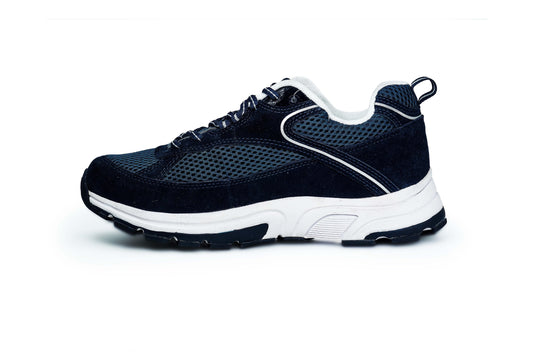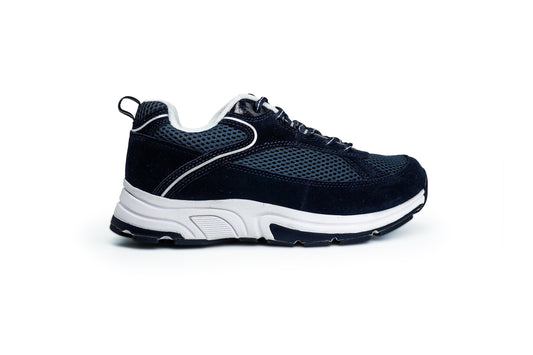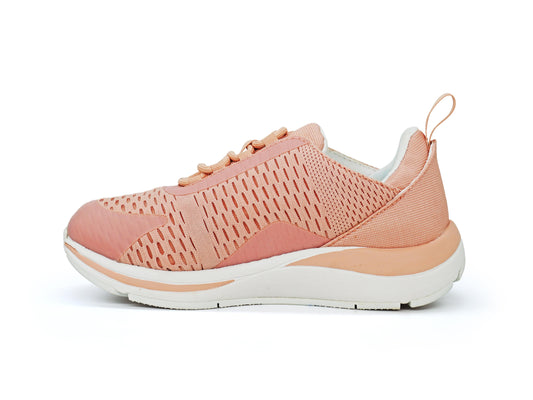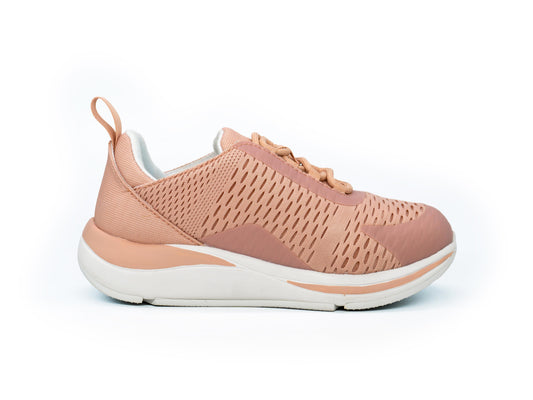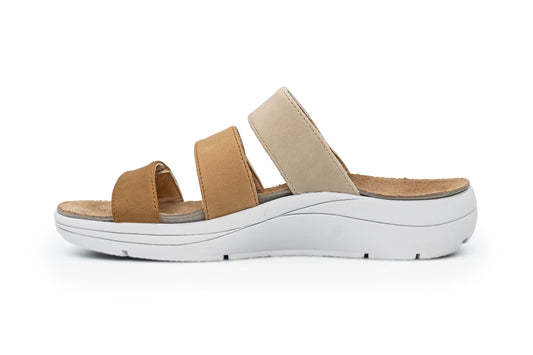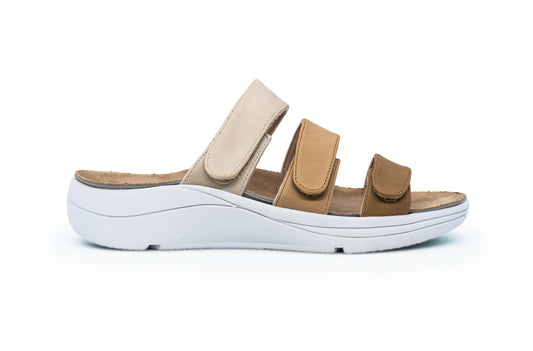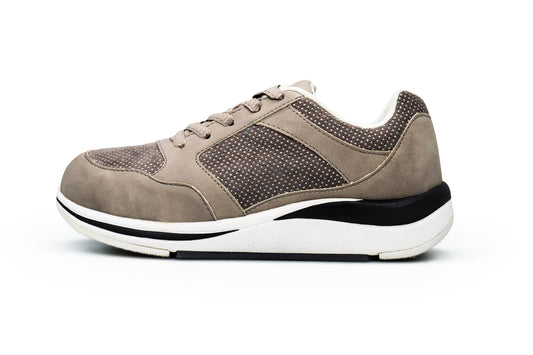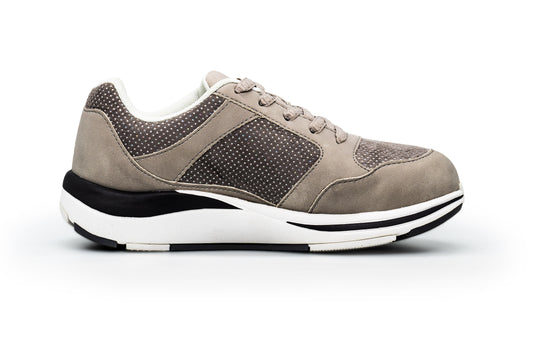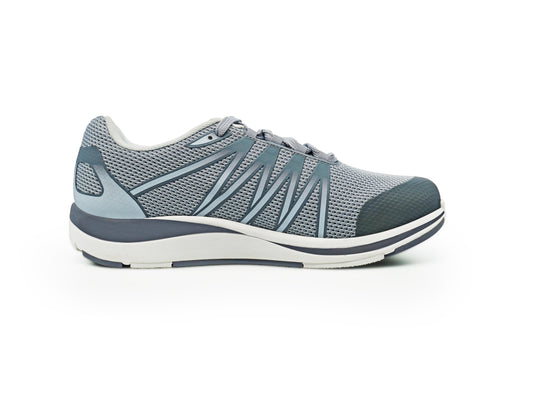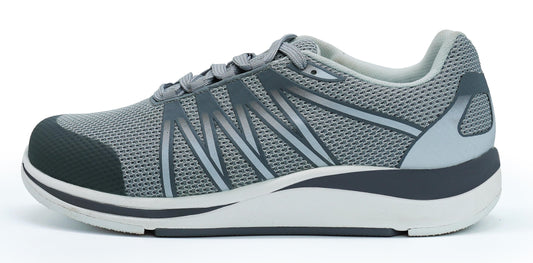-
Vendor: WOMENS
SPRINTER Diabetic & Orthopedic Athletic Shoe Rose - Womens - Rose Combo
The Sprinter women's lace-up sneaker by Drew only available exclusively at Diabeticshoe.in features our Walk Right Technology Insole and is engineered for protection and superior comfort. A slip-resistant outsole will keep you on your feet. The high rebound EVA midsole provides shock absorption to...- ₹ 11,695
₹ 12,995- ₹ 11,695
- Unit price
- / per
-
Rose Combo
-
Grey Mesh Combo
-
Vendor: WOMENS
CHIPPY Diabetic & Orthopedic Athletic Shoes - Womens - Grey Combo
Drew Chippy exclusively available at Diabetic Shoe India is our most popular casual shoes for women offers a great, new look for Drew. Chippy shoes are one of the industry's few walking shoes with double depth and two removable insoles that can accommodate prescribed...- ₹ 10,795
₹ 11,995- ₹ 10,795
- Unit price
- / per
-
Grey Combo
-
Vendor: WOMENS
BALANCE Running Shoes - Womens - Grey Mesh
The Balance women's athletic shoe features our Walk Right Technology™ Insole and is engineered for protection and superior comfort. A slip-resistant outsole will keep you on your feet. The high rebound EVA midsole provides shock absorption to reduce foot and leg fatigue. Complete with...- ₹ 10,795
₹ 11,994- ₹ 10,795
- Unit price
- / per
-
Grey Mesh
Trending Now
Popular Products
Vendor:
MENS
AARON Diabetic & Orthopedic Athletic Shoes - Mens - Navy Suede/Mesh
Walk in confidence knowing Drew Aaron only available exclusive at DiabeticShoe.in offers the proprietary Plus Fitting System® with two removable insoles plus all the therapeutic benefits Drew is famous for. With shock-absorbing inserts, flared outsoles, firm heel counters and Drilex® linings to wick away...
- ₹ 11,695
₹ 12,995- ₹ 11,695
- Unit price
- / per
-
Navy Suede/Mesh
Vendor:
WOMENS
SPRINTER Diabetic & Orthopedic Athletic Shoe Rose - Womens - Rose Combo
The Sprinter women's lace-up sneaker by Drew only available exclusively at Diabeticshoe.in features our Walk Right Technology Insole and is engineered for protection and superior comfort. A slip-resistant outsole will keep you on your feet. The high rebound EVA midsole provides shock absorption to...
- ₹ 11,695
₹ 12,995- ₹ 11,695
- Unit price
- / per
-
Rose Combo
-
Grey Mesh Combo
Vendor:
WOMENS
SAWYER Diabetic & Orthopedic Sandal - Womens - Blue Combo
Sawyer womens sandals by Drew® at DiabeticShoe.in combine an updated modern look with a hard-to-find removable insole. The removable Walk Right Technology™ footbed makes Sawyer one of the most comfortable women's sandals around! Featuring a lightweight outsole and three hook and loop adjustable straps,...
- ₹ 8,995
₹ 10,995- ₹ 8,995
- Unit price
- / per
-
Blue Combo
-
Natural Combo
Women's Athletic for Diabetic Foot
Experience the perfect balance of performance and style with DiabeticShoe.in's exclusive collection of women's athletic shoes. Designed for the modern active woman, our range offers superior support and comfort without compromising on trend-setting designs. Precision-engineered with premium materials, each pair redefines expectations for women's athletic shoes, ensuring you step into every activity with confidence and flair.
Immerse yourself in the seamless fusion of athletic functionality and high-fashion design. From advanced cushioning to targeted support, our women's athletic shoes provide an unparalleled combination of comfort and performance, crucial for those leading an active lifestyle.
Explore our curated collection at DiabeticShoe.in and confidently stride through your active pursuits where performance and style coalesce seamlessly. Enhance your understanding of foot health through insightful blogs, such as the Diabetic Footwear Research Centre and Orthopedic Footwear Research Centre.
DiabeticShoe is the exclusive dealer of Drew Orthotics, a well-known American-prescribed orthotics brand.
Learn more about us.
Sidebar
Why Choose Orthopedic & Diabetic Shoes?
Orthopedic & diabetic shoes combine soft, seamless interiors with supportive orthotic technology to protect sensitive feet from blisters, pressure, and friction. With added depth, cushioned soles, and a roomy fit, these shoes provide relief while helping to prevent foot conditions commonly associated with diabetes.
Key Features:
- Seam-Free, Padded Interiors: Each shoe is designed with a seamless lining and extra padding to prevent irritation and friction, making them ideal for individuals with sensitive feet or neuropathy.
- Orthotic Insoles with Arch Support: Built-in orthotic insoles provide gentle arch support and improve foot alignment, helping to alleviate pain from common foot issues like plantar fasciitis and flat feet.
- Lightweight, Shock-Absorbing Soles: The cushioned soles absorb impact with each step, reducing pressure on the feet, knees, and lower back. This feature is especially beneficial for individuals with diabetes, as it helps prevent undue stress on the feet.
- Wide Toe Box and Extra Depth: Designed with a spacious toe box, Orthopedic & diabetic shoes allow natural toe movement and accommodate swollen feet or foot deformities, providing a comfortable, pressure-free fit.
- Adjustable Fit Options: Many styles feature adjustable closures, such as Velcro straps or laces, allowing for a personalized fit that accommodates swelling and provides extra stability.
- Reinforced arch support: Insoles are designed to support the arch, maintain proper foot alignment, and relieve pressure on joints.
- Firm heel counter: A stiff, supportive back section prevents the heel from sliding around in the shoe, which adds stability and motion control.
- Durable construction: These shoes are built to be sturdy and provide long-lasting support to the foot's structure.
- Soft, non-binding materials: The shoe's uppers are made from soft, flexible, and often stretchy materials that conform to the foot's contours and prevent constriction, which is important for circulation
- Breathable materials: Fabrics like leather and mesh promote air circulation, keeping the feet dry and reducing the risk of fungal infections.
- Protective, non-skid sole: The sturdy outsole shields the foot from sharp objects, and the non-slip design reduces the risk of falls.
- Adjustable straps: Hook-and-loop (Velcro) straps or laces allow for easy adjustments to accommodate fluctuations in foot swelling throughout the day
Benefits of Orthopedic & Diabetic Shoes:
Both orthopedic and diabetic shoes are therapeutic footwear designed to protecy and support the feet, but they serve different primary purposes. Orthopedic shoes correct biomechanical foot issues, while diabetic shoes are specifically engineered to prevent complications in diabetic patients who are prone to foot injuries and ulcers.
- Enhanced Foot Protection: Soft, seamless interiors and cushioned support protect sensitive feet from blisters, pressure, and irritation, promoting better foot health.
- Pain Relief and Stability: Orthotic insoles and ergonomic design provide the support needed to alleviate pain and ensure stability, reducing the risk of slips and falls.
- Long-Lasting Comfort: With shock-absorbing materials and a comfortable, supportive fit, Orthopedic & diabetic shoes offer the all-day comfort you need to stay active and pain-free.
- Improve support and alignment: They feature reinforced arch support, firm heel counters, and cushioned insoles that help maintain proper alignment of the feet and ankles. This also helps with issues like flat feet and high arches.
- Reduce pain: Orthopedic footwear is effective at relieving foot pain caused by conditions like plantar fasciitis, heel spurs, bunions, and arthritis. The extra cushioning helps absorb shock and minimizes pressure on sensitive areas.
- Enhance mobility: By providing stability and support, these shoes make it easier and more comfortable to walk, stand, and move. This is especially beneficial for those with arthritis, injuries, or other conditions that affect gait.
- Accommodate foot deformities: Features like wide toe boxes reduce friction and pressure on bunions and hammertoes, preventing discomfort and the condition from worsening.
- Distribute pressure: The design ensures that weight is evenly distributed across the foot, which reduces stress on joints and other key areas.
- Improve overall posture: By promoting better foot and ankle alignment, orthopedic shoes can have a positive effect on your posture, which in turn can relieve pain in the knees, hips, and back.
- Prevent foot ulcers: Diabetes can cause nerve damage that reduces sensation in the feet. A minor cut or blister can go unnoticed and develop into an ulcer. Diabetic shoes have seamless interiors and soft, non-binding uppers to eliminate friction and pressure points that can lead to skin breakdown and ulcers.
- Protect against injury: Stiff toe boxes and durable construction shield feet from accidental bumps or impacts, which is crucial for those with reduced sensation who might not feel an injury.
- Enhance circulation: Designed with extra depth and wide toe boxes, diabetic shoes promote healthy blood flow by preventing constriction. The reduced pressure on the feet helps improve circulation, which is often poor in individuals with diabetes.
- Accommodate foot deformities and swelling: The roomy design provides space for common diabetes-related foot changes, such as swelling, bunions, and hammertoes. Adjustable closures can accommodate daily fluctuations in foot size.
- Reduce risk of amputation: By preventing and managing foot injuries and infections, proper therapeutic footwear is a critical tool for reducing the risk of amputation associated with severe diabetic foot complications.
- Ensure optimal foot health: Regular use of diabetic shoes, along with daily foot checks and hygiene, is a key part of a comprehensive foot care plan for diabetics, leading to enhanced mobility and independence.
Ideal for Everyday Activities and Long Hours
Orthopedic & diabetic shoes are crafted to support you through any daily activity, from work to casual outings:
- Home and Daily Wear: Perfect for relaxing or light walking, these shoes keep your feet cushioned and comfortable all day.
- Errands and Social Outings: With a stylish yet practical design, Orthopedic & diabetic shoes allow you to stay active and look great without compromising on foot health.
- Protect your feet with Orthoshoes diabetic shoes, designed to provide gentle, reliable support and comfort for sensitive feet. Discover footwear that’s as protective as it is comfortable.
Shop the collection today and step into comfort and peace of mind!
FAQs
Can women with diabetes still participate in athletic activities?
Yes, absolutely. Regular, low-impact exercise like walking or cycling can be very beneficial for people with diabetes. It is crucial, however, to take extra precautions to protect your feet and prevent serious complications like nerve damage and ulcers. If you have existing nerve damage, a podiatrist can recommend the safest athletic activities for you.
What should I look for in athletic shoes?
The right athletic shoes are crucial for preventing injury. Key features to prioritize include:
A proper fit: A shoe should fit well from the start, with no need for a "break-in" period. Shop for shoes later in the day when your feet are slightly swollen to ensure a comfortable fit.
A wide and deep toe box: This provides ample room for your toes to move, preventing pressure, blisters, corns, and calluses.
Breathable materials: Look for mesh, canvas, or leather uppers to allow for proper airflow, which helps prevent moisture buildup and fungal infections.
Cushioned, seamless interior: A soft, smooth, seamless interior minimizes friction and pressure points, significantly reducing the risk of sores and blisters.
Excellent arch support: Thick, cushioned soles with good arch support help absorb impact, distribute pressure evenly, and improve stability.
How do custom orthotics help diabetic athletes?
Custom-made orthotics, which are different from off-the-shelf inserts, provide specialized benefits for diabetic athletes:
Pressure redistribution: They distribute pressure evenly across your feet, protecting high-pressure areas and reducing the risk of ulcers and blisters.
Enhanced stability: They provide better arch support to stabilize your feet, improving balance and reducing the risk of falls.
Cushioning and protection: They offer additional cushioning that protects your feet from potential injury, which is especially important if you have neuropathy.
Improved circulation: By promoting proper foot alignment and mechanics, orthotics can help improve blood flow.
What kind of socks should I wear with athletic shoes?
Moisture-wicking material: Fabrics like polyester or wool pull sweat away from the skin, keeping your feet dry and reducing the risk of fungal infections.
Seamless design: Prominent seams can cause rubbing and lead to blisters. Seamless socks prevent this irritation.
Non-binding fit: They should not have tight elastic bands that can constrict blood flow. They use a stretchy, form-fitting fabric to stay in place.
Padding: Extra cushioning in the heel and ball of the foot offers additional protection and shock absorption.
Light colors: Light-colored or white soles can help you easily spot blood or other drainage that may indicate an injury.
What are the warning signs of a foot problem?
Tingling, burning, or pain in your feet
Loss of feeling in your feet
Changes in the color or temperature of your feet
Swelling in the foot or ankle
A slow-healing cut, sore, or blister
Thick, yellow toenails or other signs of fungal infection
An unusual foot odor that won't go away
Changes in the shape of your feet
Is it safe to exercise with foot problems like athlete's foot or thickened nails?
Consult a specialist: It is best to have athlete's foot, thick or yellowed toenails, corns, or calluses treated by a podiatrist before beginning an athletic regimen.
Never self-treat: Do not attempt to remove corns or calluses yourself with medicated pads or other at-home treatments.
Protect your feet: If approved to continue exercising, ensure your footwear is well-fitting and your socks are clean and dry.
Are there athletic shoes made specifically for diabetic women?
Look for certification: Check if the shoes are specifically designated for diabetic use and approved by a recognized health organization.
Prioritize fit: Opt for extra-wide, extra-depth shoes with adjustable closures (laces or Velcro) to accommodate swelling and custom orthotics.
Seek expert fitting: It is best to get professionally measured and fitted by a podiatrist or certified shoe fitter.
How Does Diabetes Affect My Feet?
High glucose levels in people with diabetes often cause the loss of blood circulation and nerve function that can lead to problems with the feet. The most common foot ailments of people with diabetes include diabetic foot ulcers, gangrene, diabetic neuropathy, and infections.
Where can these shoes be purchased?
They can be directly purchased and customised on our website. They are available in various designs suited for everyone.
Recently Viewed Products
- Choosing a selection results in a full page refresh.

